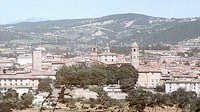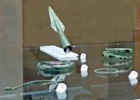


Città di Castello
Aes Signatum (early 3rd century BC)
An aes signatum (inscribed bronze ingot)in the Staatliche Museen, Berlin , which was cast (probably in Rome) with a relief of a bull on each side, was later inscribed in Umbrian on one side:
“vukes sestines”
“of (or from) the vicus (village) [or, less probably, the lucus (wood)] of the Sestines”
The Sestines presumably lived on the site of the later municipium of Sestinum, modern Sestino, a town in the central Apennines, some 50 km north of Città di Castello.
The Romans produced ingots of this kind for monetary purposes in the period before the use of “aes grave” (cast bronze coins). The one described here belongs to a group characterised as “toro/toro”, because of the bull depicted on each side. These date to the first half of the 3rd century, and were probably used to pay allied soldiers for their service with the Roman army. The earliest record known of Umbrian solders fighting among the allies in the Roman army is from Dionysius of Halicarnassus and relates to the Battle of Asculum (279 BC).
The Berlin museum obtained the ingot described here from the collection of the renowned numismatist Ernst Justus Haeberlin (died 1925), who had bought it in 1907 and included it in his seminal book “Aes Grave: Das Schwergeld Roms und Mittelitaliens Einschließlich der ihm Vorausgehenden Rohbronzewährung” (1910). It had apparently been found by charcoal makers in a wood near Città di Castello in 1899. The most likely explanation is that it had been a votive offering made by the Sestines in a sanctuary here.
This inscription is discussed by Cristina Migliorati in the catalogue of Umbrian inscriptions referenced below. (It also features in my page on Later Umbrian Inscriptions).
Area around Città di Castello
The earliest surviving historical records of Tifernum Tiberinum, which date to the 1st century AD, are ambivalent about its ethnic origins:
-
✴Pliny the Elder placed “the Tifernates surnamed Tiberini” among the people of the Augustan Sixth Region (Umbria).
-
✴However, Pliny theYounger, his nephew and adopted son, suggests that it was in Tuscany (a location more appropriate to the Augustan Seventh Region, Etruria):
-
•In his Letter LII to Domitius Apollinaris), he describes the “Tuscan villa” on the estate that he had inherited from his uncle/ adoptive father; and
-
•In his Letter XXXVIII to Fabatus, (his wife’s grandfather), he promises:
-
“We shall make only one short stop [en route to see Fabatus], for we intend turning a little out of our way to go into Tuscany: not for the sake of looking upon our estate ... but to perform an indispensable duty.... [in] a town near my estate, called Tifernum Tiberinum ....”
Colle Plinio, a hill behind San Giustino, some 10 km north of Città di Castello, has long been claimed as the site of the Pliny family estate, a tradition that has been confirmed by recent excavations. Thus, both the estate and the town were the area of modern Umbria. There are at least three ways of interpreting the literary references above in relation to the situation as it was in the 1st century AD:
-
✴Pliny the Elder might have been mistaken in placing Tifernum Tiberinum in the Sixth rather than the Seventh Region.
-
✴The border between the Sixth and Seventh regions could have been slightly to the south of the modern border, placing the estate and its villa in the Seventh Region but leaving Tifernum Tiberinum in the Sixth Region. (In his letter to Fabatus, Pliny the Younger could have meant that he would stop briefly at his Tuscan estate so that he could visit the nearby town in Umbria).
-
✴The Augustan administrative regions could have been less respectful of historic authenticity than is usually supposed. In that case, Tifernum Tiberinum could have had been placed in the Sixth Region despite the existence of what Pliny the Younger (and presumably others) perceived to be its obvious Etruscan heritage.
Simone Sisani (referenced below, at pp. 7§1-2) suggested that the last of these possibilities is the correct one. The insight underlying this hypothesis is that the classical sources identify only the lower reaches of the Tiber as forming the boundary between the ancient territories of Etruria and Umbria. In its upper reaches, the Tiber might well have had Etruscan people settled on both banks.
Riosecco and Lerchi


-
✴a fibula with an arched bow and quadrangular cross section, originally covered with amber and bone;
-
✴three bracelets;
-
✴a small chain made of multiple rows of interweaved rings;
-
✴a distaff; and
-
✴a lance-head and shaft.
Simone Sisani (referenced below, at pp. 65-6) has suggested that the settlement at Riosecco was abandoned in the 6th century BC because of an Etruscan invasion, at which point the inhabitants moved to the site that was to become the Roman city (described in my page on Tifernum Tiberinum: Roman Città di Castello).
Fabbrecce and Trestina
Evidence of “princely” tombs have been found near Fabbrecce and Trestina, some 10 km to the south of Città di Castello, on the opposite bank of the Tiber:
-
✴A princely tomb (mid 7th century BC) excavated in 1901 at Fabbrecce contained Etruscan bronzes from a chariot and pieces of armour that included a bronze helmet from Picenum (across the Apennines from Umbria).
-
✴An eclectic collection of bronze and iron grave goods from what seems to have been a necropolis in use in the 7th and 6th centuries BC was discovered at Trestina in 1879. The most striking were the remains of two cauldrons:
-
•One of the cauldrons (late 7th century BC) was decorated the heads of ibexes and supported by a tripod bovine feet, decorated with heads of ibexes, stags and bulls.
-
•The other, smaller, cauldron was decorated with griffins’ heads.
Many of the finds from Trestina and Fabbrecce found their way to the Museo Archeologico, Florence early in the 20th century and have recently been moved to the Museo dell’Accademia Etrusca e della Città di Cortona.
These prestige grave goods suggest the emergence of a ruling (probably Etruscan) élite that had profited from the strategic and commercial importance of the area, which arose from its proximity to the river and from its equally important access to the passes across the Apennines that led to the Adriatic coast. Simone Sisani (referenced below) has suggested that the growing resources of these Etruscan nobles allow them to drive the Umbrian settlers from Riosecco and perhaps to found a new Etruscan settlement on the site of Città di Castello,
Monte Acuto
A fortified Umbrian settlement has been excavated at the summit of Monte Acuto, on the right bank of the Tiber, some 30 km south of Città di Castello (near Umbertide). It was associated with other nearby fortified sites that facilitated control of the upper Tiber valley. The remains of a sanctuary that was in use in the 6th - 4th centuries BC were discovered within the summit fortifications during excavation in 1986-95. Some of the large number of votive bronzes from these excavations are now exhibited in the Museo di Santa Croce, Umbertide. They indicate that the sanctuary was probably dedicated to a rural deity, and that the people who used it included a large number of ordinary members of the local rural society.
Read more:
C. Migliorati, Entry 57, in
L. Agostiniani et al. (Eds), “Screhto Est: Lingua e Scrittura degli Antichi Umbri”, (2011) Città di Castello
S. Sisani, “Dirimens Tiberis? I confini tra Etruria e Umbria”, in
F. Coarelli and H. Patterson (Eds) “Mercator Placidissimus: the Tiber valley in Antiquity: New Research in the Upper and Middle River Valley”, (2009) Rome
F. Lo Schiavo and A. Romualdi (eds), “I Complessi Archeologici di Trestina e di Fabbrecce nel Museo Archeologico di Firenze”, (2010) Rome
Scarpignato (Ed.), “Alle Radici della Città: Testimonianze Archeologiche di Tifernum Tiberinum”, (2004), Perugia
Return to the page on the History of Città di Castello.

